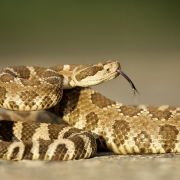Throughout the United States, there are 15 species of rattlesnakes, and three of those live in the state of Colorado. Those are the prairie rattlesnake, the massasauga, and the midget faded rattlesnake. The one dominant species in northern Colorado is the prairie rattlesnake, and if not careful, they can be a danger to your pets.
However, knowing basic rattlesnake bite safety could end up saving your pet’s life. As a pet owner, a rattlesnake bite can be scary, along with one of the most dangerous situations that your pet could face. Therefore, not only do you need to know how to act to save their life, but you also need to know what to do within minutes after the bite occurs.
The experts at Larimer Humane Society advise you to pay close attention to the below list as it could save either yourself or your pet one day:
WHAT NOT TO DO:
Don’t try to scare away the snake
Your pet’s first instinct after being bitten by a snake could be to strike back. But, instead, act quickly to get away as snakes have a vast striking distance.
Don’t use a tourniquet.
Using a tourniquet could restrict blood flow near the bite, which could lead to the venom being concentrated in one area and the blood not being oxygenated. This means your pet could suffer from necrosis, which is tissue death.
Don’t suck the venom out.
Once snake venom is in the bloodstream, it’s there to stay. If you try to suck the venom out of your pet’s wound, it won’t work! You need to seek out a veterinary emergency center immediately as every minute is precious.
WHAT TO DO:
Call emergency vet services immediately
As soon as your dog or cat is bitten, the venom will enter their bloodstream. This means it is of the utmost importance to get them treatment as quickly as possible.
Check for the symptoms of a rattlesnake bite.
Unless your pet was on a leash and near you when bitten, you might not be fully aware of what happened. If your pet is acting strange or you notice a sudden personality change, it could be imperative to check for the following rattlesnake symptoms:
- Bleeding puncture wounds
- Swelling and bruising around the puncture wound
- Slow or ragged breathing
- Whimpering in pain or fear
- Sluggish behavior, lethargy, or trembling
Keep the wound below heart-level
It’s the goal to keep the infected blood away from the heart as long as possible. Keeping the bite lower than the heart can help with this.
“There are rattlesnake vaccines available for pets who live in extremely remote areas which can be discussed with your veterinarian to determine if it’s an option for your animal,” says Larimer Humane Society Supervising Veterinarian Dr. Lindsey Gapstur. “Also, there is rattlesnake avoidance training for dogs that can be helpful for animals who are regularly in regions with rattlesnakes.”
While the risk of getting bitten by a rattlesnake is low in northern Colorado, it’s crucial to be prepared if it does occur. The key is to remain calm while you seek out emergency veterinary services. Rattlesnake bites are treatable with the proper antivenom, but it’s vital that you get to the hospital in time.










